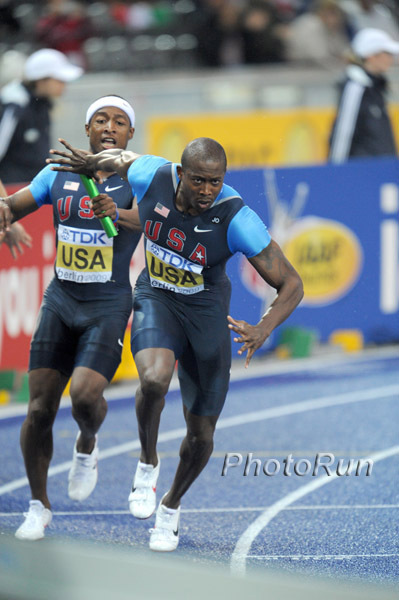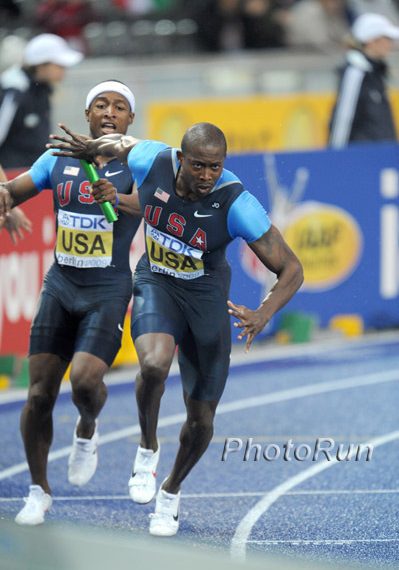
Mike Rodgers handing off to Shawn Crawford, August 21, 2009, photo by PhotoRun.net.
James Dunaway is one of the keenest observers of our sport. He has been to the past fifteen Summer Olympics, over fifty years of NCAA outdoor championships and more track meets than most of us see in a lifetime. If you can find it, his book, written for Sports Illustrated in the sixties, on Track & Field technique is an amazing asset for any coach.
James Dunaway has been the editor of American Track & Field now for about five years. I see him as mentor, editor and champion of our sport. He does not suffer fools.
After watching the men’s 4 x 100 meters be disqualified on an exchange zone infraction (which I could not see with reviewing the video), and the injury of Muna Lee in the 4 x 100 meters, I believe that re running the following piece makes a lot of sense.
I have met Benita Fitzgerald Mosely, and while I believe she has been thrown into the lion’s den, her enthusiasm, her creativity and some time will help her make our High Performance area more successful. I also am pleased with Terry Crawford as Director of Coaching-having a coach with such experience will help us formulate a coaching education program that will be the envy of the world.
That is what frustrates me so much about the 4 x 100 meter relay. As we are finally moving up in the middle distances, distances, we are being dusted by relay teams who can get the baton around the track, and in the exchange zone, but who are no where as fast. Our system is not working, and making apologies for it does not make sense.
My suggestion: Either come up with a national sprint relay system, stick with it, or stop sending the teams to international events. It is embarrassing…
It’s time for a national system for the 4X100
In November 1997, Dennis Mitchell, an experienced 4×100 relay runner, spoke to Track & Field News about the frequent U.S. 4×100 problems at the international level, “We…have to develop a system that’s more consistent year after year. Consistent with our coaching staff, our athletes, our ideas about running the relay.”
“Every year, we get a brand new coaching staff (with) its own style of coaching – and the athletes have to learn how to adapt to it. Practice isn’t the problem we have; it’s just that we need a more consistent system.â€
AT&F believes the U.S. should adopt a national system for the 4×100.
It should be taught in grade school and kids’ meets and made standard for junior high teams, for senior high teams, for college teams – so by the time a sprinter earns a spot on the national team, he or she knows exactly what to expect when passing or receiving the baton. That would probably solve 90% of the problems we’ve had in Olympic and World Championships races.
Stan Huntsman described an optimum baton-passing system in an article he once wrote for us:
The entire strategy of the 4×100 is built around the baton exchanges. The object is to keep the baton moving toward the finish line at as close to full speed as possible.
Each runner carries the baton in the same hand for the entire distance of the leg. The lead-off runner carries the baton in his or her right hand. At the exchange, the baton is handed to the left hand of the outgoing runner. This second-leg runner passes the baton to the right hand of the third runner, who carries it in the right hand and passes it to the left hand of the anchor runner.
The first and third runners run on the inside part of their lane. The second and fourth runners run on the outside half of their lane. That makes it easier for the first runner, on the inner half of the lane and with the baton in the right hand, to lay it in the outstretched left hand of the second runner who is accelerating in the outer half of the lane.
The second runner arrives running on the outer half of the lane with the baton in the left hand and places it in the outstretched right hand of the third runner, who is positioned on the inside half of the lane.
The exchanges are ‘blind’ passes – meaning that the outgoing runner does not see the baton during the exchange. Instead, he or she concentrates on accelerating into the exchange zone.
Each runner in the exchange has certain responsibilities.
Duties of he incoming runner:
1. Run all the way through the zone, staying in your lane.
2. Carry the baton holding the near end of the stick, giving the outgoing runner plenty of baton to get hold of.
3. Approximately 15 meters before you reach the zone, give a verbal command to the outgoing runner. Usually a hard-sounding word such as “hand†is shouted.
4. Extend your arm with the baton to the outstretched hand of the outgoing runner, and then simply place (do not slap) the baton in the open hand of the outgoing runner. Stay in your lane until all the other exchanges have been made.
Duties of the outgoing runner:
1. Place a marker (usually tape) at a spot on the track that you can easily see. This is called the “acceleration point.†When the incoming runner reaches this point, the outgoing runner stops looking at the incoming runner and starts running.
2. Stand in a crouching position and look over your shoulder, waiting for the incoming runner to reach your acceleration point. To help you see, your rear leg can be slightly open, but the foot of your front leg must be pointed in the exact direction of your intended run.
3. Run as fast as you can in your acceleration.
4. When you hear your teammate say “hand,†extend your hand in an open, palm-up position with your arm straight back (parallel to the ground).
5. When you feel the baton touch your hand, close your fingers around it firmly. Once you have secured the baton, run to the next runner or the finish line.
Follow these fundamentals, and practice them constantly, and you’ll be able to execute your 4×100 baton exchanges perfectly every time.
How about it, coaches? How about it, USATF?
— James Dunaway
For more on the sport, please check http://www.runningnetwork.com
RelatedPosts
Author

Larry Eder has had a 52-year involvement in the sport of athletics. Larry has experienced the sport as an athlete, coach, magazine publisher, and now, journalist and blogger. His first article, on Don Bowden, America's first sub-4 minute miler, was published in RW in 1983. Larry has published several magazines on athletics, from American Athletics to the U.S. version of Spikes magazine. He currently manages the content and marketing development of the RunningNetwork, The Shoe Addicts, and RunBlogRun. Of RunBlogRun, his daily pilgrimage with the sport, Larry says: "I have to admit, I love traveling to far away meets, writing about the sport I love, and the athletes I respect, for my readers at runblogrun.com, the most of anything I have ever done, except, maybe running itself." Also does some updates for BBC Sports at key events, which he truly enjoys. Theme song: Greg Allman, " I'm no Angel."
View all posts




















